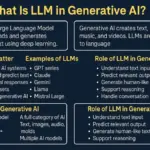Artificial Intelligence is everywhere right now — from your smartphone to your office tools, and even in everyday apps. But with AI becoming mainstream, a new buzzword is taking over the tech scene: LLMs or Large Language Models. Many people mix up AI and LLMs, assuming both are the same thing. But actually, there’s a big difference.
Today, we break down AI vs LLMs in a clean, simple way — so even non-tech users can understand what’s happening behind the scenes of tools like LLM ChatGPT, LLM model, and generative AI platforms.
Key Highlights
- AI is a broad technology that allows machines to mimic human intelligence.
- LLMs are a specific type of AI trained on huge amounts of text.
- Tools like ChatGPT, Gemini, and Claude are examples of LLM-based systems.
- LLMs are great for text generation, translation, coding help, and reasoning tasks.
- AI covers robotics, vision systems, machine learning, and much more beyond LLMs.
AI: The Big Umbrella
AI, or Artificial Intelligence, is basically any computer system that can perform tasks that normally need human intelligence.
These include:
- Decision-making
- Pattern recognition
- Speech recognition
- Robotics
- Machine learning
- Deep learning
So, AI is a super-wide category. Everything from self-driving cars to facial recognition systems to deep learning networks falls under AI.
LLMs: A Specialized Part of AI
LLMs — Large Language Models — are a more focused technology within AI.
These models are trained on massive datasets of text (internet articles, books, code, etc.) and learn:
- Patterns in language
- Context
- Grammar
- Knowledge associations
- Writing styles
Some popular LLM examples include:
- ChatGPT
- GPT-4o
- Gemini 2.0
- Claude
- Llama 3
LLMs are extremely powerful in tasks like:
- Writing and content creation
- Code generation
- Translation
- Question-answering
- Summarization
They are the backbone of most modern generative AI platforms.
AI vs LLMs: The Core Difference
Here’s the simplest comparison:
| Feature | Artificial Intelligence (AI) | Large Language Models (LLMs) |
|---|---|---|
| Definition | Broad technology mimicking human intelligence | AI models that understand and generate human-like text |
| Scope | Robotics, vision, ML, deep learning, NLP, etc. | Only text-based intelligence |
| Example | Self-driving cars, Siri, fraud detection | ChatGPT, Llama 3, Gemini |
| Input Type | Images, audio, video, sensors, text | Mostly text |
| Output | Actions, predictions, decisions | Text-based answers |
In short:
All LLMs are AI, but not all AI is an LLM.
Why LLMs Matter in Generative AI
When people talk about generative AI — tools that create text, images, or code — LLMs are right at the center.
What is LLM in generative AI?
It is the text-based engine that understands prompts and generates human-like responses. Without an LLM, tools like ChatGPT, Claude, or any deep learning tutorial for language wouldn’t exist.
Types of LLMs
There are several categories within LLMs:
- Decoder-only models (ChatGPT, Llama)
- Encoder-decoder models (BART, T5)
- Open-source LLMs
- Closed/proprietary LLMs
- Multimodal LLMs (process text + image + audio)
Each type is designed for different performance goals.
Specifications & Features of Modern LLMs
Although LLMs are software models, they also have “specifications,” similar to smartphone or chipset specs.
Common LLM Specs:
- Parameters: 7B, 13B, 70B (the higher the number, the smarter the model)
- Training Data Size: trillions of tokens
- Architecture: Transformer-based neural networks
- Capabilities: reasoning, coding, translation, conversation
Key Features:
- Human-like conversation
- Deep understanding of context
- Multilingual support
- Ability to generate long-form content
- Code understanding and debugging
- Real-time reasoning abilities
Price & Availability of LLMs
Most LLMs come in two versions:
Free (basic) models
- ChatGPT Free
- Google Gemini Nano
- Llama 3 open-source models
Paid (premium) models
Paid models offer better reasoning and creativity.
Examples:
- ChatGPT Plus
- Gemini Advanced
- Claude Pro
Prices vary from ₹1,000–₹2,000 per month, depending on the provider.
How to Use or “Buy” an LLM (Step-by-Step)
While you don’t “buy” an LLM like a smartphone, you can subscribe or download one.
1. Choose your platform
Pick any major LLM provider such as:
- OpenAI
- Anthropic
- Meta (for open-source models)
2. Create an account
Signup using email or mobile number.
3. Select free or premium
Most users start with free access and upgrade later.
4. Start using the model
You can:
- Chat directly
- Use the mobile app
- Download open-source LLMs locally
5. Integrate it into workflows
For businesses, APIs can be added into:
- Apps
- Websites
- Internal tools
Frequently Asked Questions (FAQs)
1. Is an LLM the same as AI?
No. AI is a broad field, and LLMs are just one category within AI.
2. What is the use of LLMs?
They are used for writing, coding, reasoning, translation, and generating text-based outputs.
3. Are LLMs part of generative AI?
Yes, they are the core engine behind most generative AI tools.
4. What is the difference between LLM vs generative AI?
LLMs generate text.
Generative AI includes text, images, audio, and video creation.
5. Can I train my own LLM?
Yes, but it requires heavy hardware, huge datasets, and deep learning expertise.
Conclusion: Why AI and LLMs Are Changing Everything
AI is transforming the world, but LLMs are making that transformation visible to everyday users. Whether you use ChatGPT, Llama, or Gemini, LLMs enable natural conversation, smarter apps, and powerful productivity boosts. Understanding the difference between AI and LLMs helps you appreciate how far technology has come — and how much more innovation is on the way.
If you are exploring LLM AI, learning through an LLMs deep learning tutorial, or comparing LLM vs generative AI, this is the right time to dive in. The future belongs to intelligent tools — and LLMs are leading that wave.








